AMD Radeon RX 480 Review
Its performance won’t blow you away, and neither will its price.
Leading into the launch of the Radeon RX 480 graphics card, AMD claimed its $239 graphics card would deliver “VR capability common in $500 GPUs.” That’s a bold claim, considering Nvidia’s GTX 1070 offers great VR performance for under half a grand. While it certainly isn’t as fast as Nvidia’s newest GPU, the RX 480 is able to punch above its weight class. I put the card through its paces with over a dozen benchmarks. Read on to find out how fast the card truly is.
Design
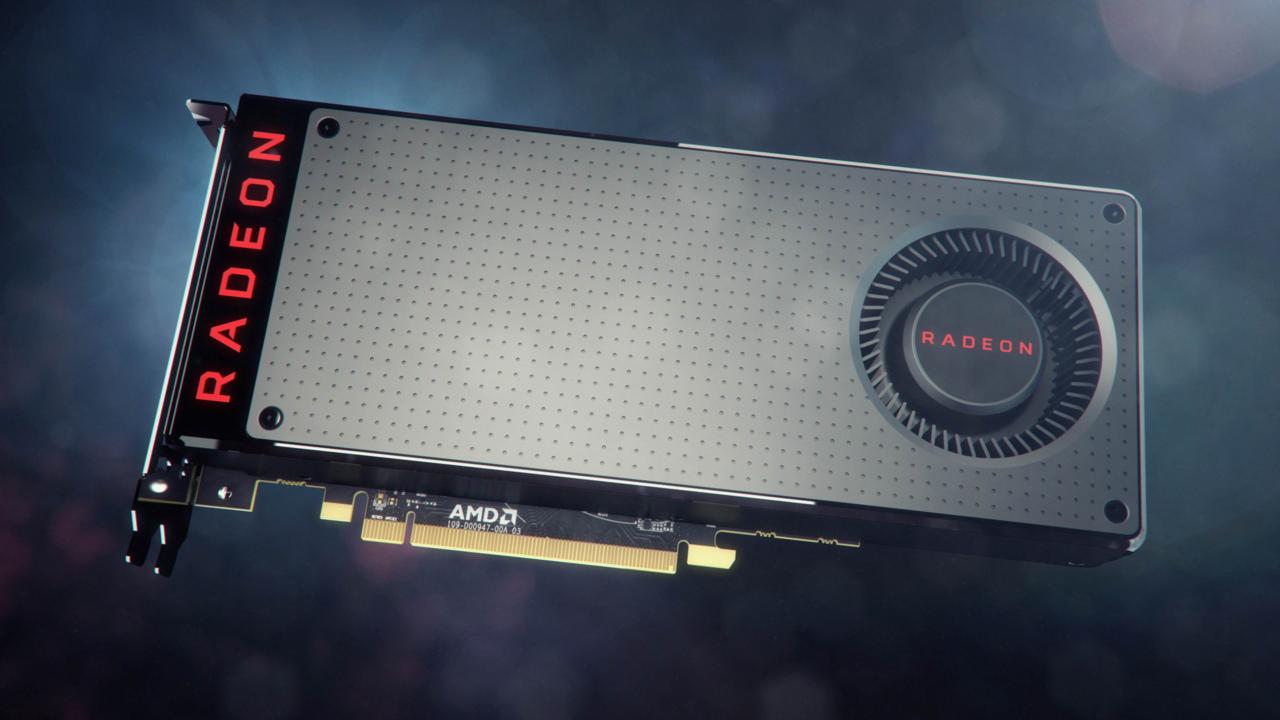
Aesthetically, the RX 480 looks pretty simple. The graphics card uses a centrifugal fan and carries a 150-watt TDP GPU via a single six-pin power connector. In terms of ports, the RX 480 offers three DisplayPort connectors and one HDMI 2.0b port, which makes the card HDR-capable.
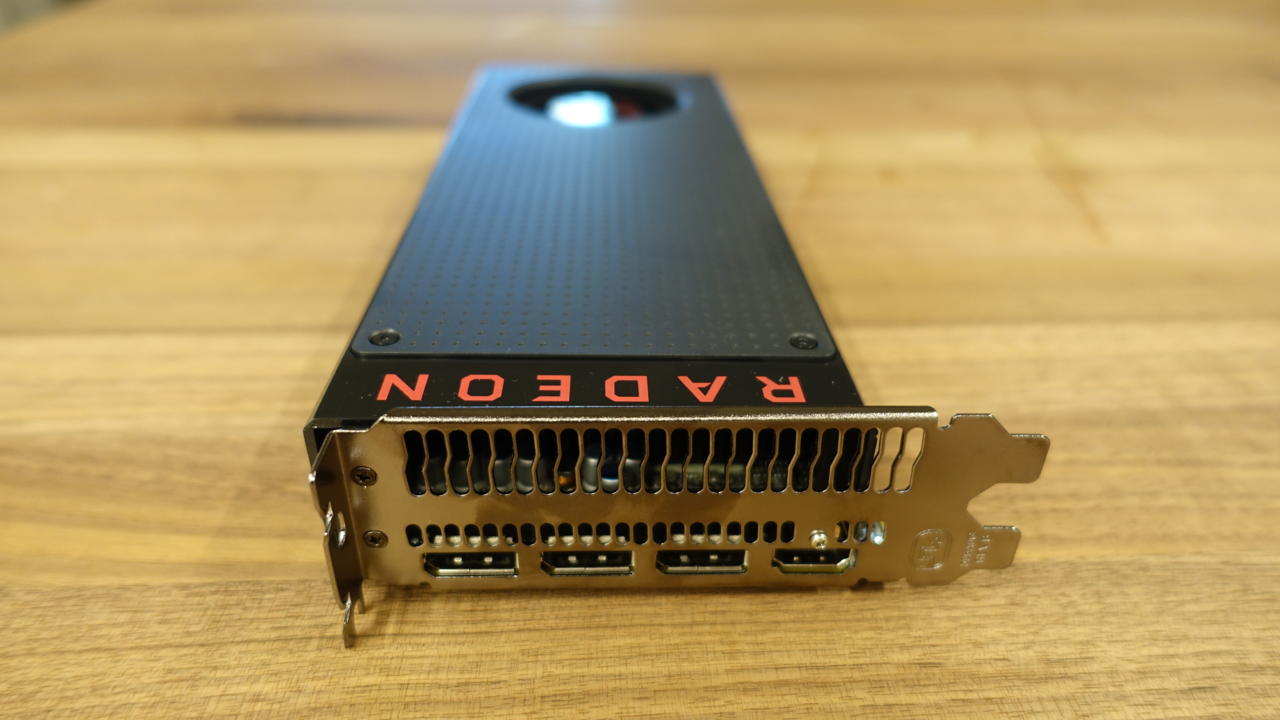
Specs
| AMD Radeon RX 480 | AMD Radeon Fury | AMD Radeon Nano | Nvidia GeForce GTX 1080 | Nvidia GeForce GTX 1070 | Nvidia GeForce GTX 980 | Nvidia GeForce GTX 970 | |
| Stream Processors/CUDA Cores | 2304 | 3584 | 4096 | 2560 | 1920 | 2048 | 1664 |
| Texture Units | 144 | 224 | 256 | 160 | 120 | 128 | 104 |
| ROPs | 32 | 64 | 64 | 64 | 64 | 64 | 56 |
| Boost Clock | 1266 MHz | 1000MHz | 1000MHz | 1733MHz | 1683MHz | 1216MHz | 1178MHz |
| Memory Clock | 7/8Gbps GDDR5 | 1Gbps HBM | 1Gbps HBM | 10Gbps GDDR5X | 8Gbps GDDR5 | 7Gbps GDDR5 | 7Gbps GDDR5 |
| Memory Bus Width | 256-bit | 4096-bit | 4096-bit | 256-bit | 256-bit | 256-bit | 256-bit |
| VRAM | 4/8 GB | 4GB | 4GB | 8GB | 8GB | 4GB | 4GB |
| FP64 | 1/16 | 1/16 | 1/16 | 1/32 | 1/32 | 1/32 | 1/32 |
| Transistor Count | 5.7B | 8.9B | 8.9B | 7.2B | 7.2B | 5.2B | 5.2B |
| Teraflops | 5.8 | 7.2 | 8.19 | 8.9 | 6.5 | 4.6 | 3.9 |
| TDP | 150W | 275W | 175W | 180W | 150W | 165W | 145W |
| Manufacturing Process | 14nm FinFet | TSMC 28nm | TSMC 28nm | 16nm FinFET | 16nm FinFET | TSMC 28nm | TSMC 28nm |
| Architecture | GCN 2.0 | GCN | GCN | Pascal | Pascal | Maxwell | Maxwell |
| GPU | Polaris 10 | Fiji | Fiji | GP104 | GP104 | GM204 | GP204 |
| Launch Date | 06/29/16 | 07/14/15 | 09/10/15 | 5/27/2016 | 6/10/2016 | 9/18/2014 | 09/18/14 |
| Launch Price | $200/$240 | $549 | $649 | $599/$699 | $379/$449 | $549 | $329 |
Note: Specs like stream processors, CUDA cores, and core clocks, etc. should only be used as a frame of reference against other cards within the same family for an apples-to-apples comparison.
While it certainly isn’t as fast as Nvidia’s newest GPU, the RX 480 is able to punch above its weight class.
The RX 480 offers 2304 stream processors, 5.7 billion transistors, and 5.8 teraflops of computing performance. If you look at the comparative spec chart above, you’ll notice that the RX 480 shows a lot of deficiencies here compared to its more expensive 2015-released siblings. This is already a tell-tale sign that the RX 480 won’t be as fast as the Fiji-based GPUs before it, though the Polaris card does have some advantages. While the RX 480 has less stream processors, transistors, and teraflops than the aforementioned cards, one good thing that it has less of is a lower thermal design point. With a 150-watt TDP rating, it consumes less power (and coincidentally puts it on the same power playing field as Nvidia’s GTX 1070). Despite this, however, it also offers faster clock speeds with a 1120MHz base clock and a boost clock of 1266MHz. You can partially attribute this to its more compact 14nm production process, which helps it run more efficiently compared to the company’s previous 28nm cards.
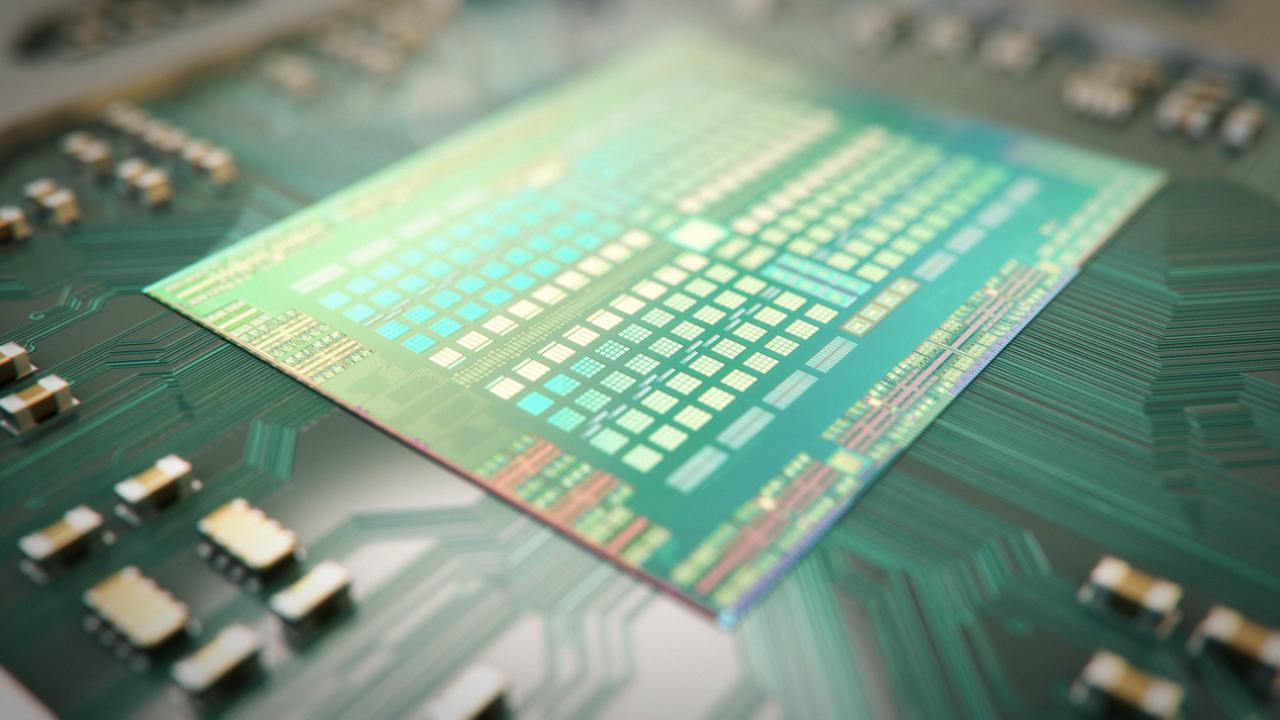
While the 4GB video RAM version of the RX 480 will start at $200 , the 8GB version that I’m reviewing here has twice as much VRAM as all the aforementioned AMD cards and retails for $239. Unfortunately, however, it does not use high-bandwidth memory (HBM) like the Fiji-based cards before it. HBM is a more efficient memory type which moves the VRAM, or frame buffer, as it’s also known, closer to the GPU to improve bandwidth per watt. The issue with HBM, however, is that it’s really complicated to manufacture, which causes yields to run low. Having said this, the RX 480 does use 8Gbps GDDR5 VRAM, which is currently the fastest GDDR5 frame buffer on the market.
Benchmarks
For my test bench, I’m using the same system that I used to review Nvidia’s GeForce GTX 1080 and 1070 GPUs. It’s a rig with an Intel Core i7-5930K Haswell-E CPU clocked at 3.9GHz coupled with 16GB of DDR4 RAM clocked at 2133MHz running in quad channel mode.
For our comparative cards, I’m pitting the RX 480 against AMD’s own R9 Fury and R9 Nano GPUs, which currently retail for $550 and $530, respectively. On the Nvidia side, I’m comparing it against the GTX 1080, 1070, 980, and 970, which currently retail for roughly $660, $420, $430, and $300, respectively. As the GTX 970 is closest in price to the RX 480, it will be my main point of reference.
For consistency and to encapsulate a wide range of data, I’m using the same synthetic, VR, and game benchmarks that I used in my GTX 1080 and GTX 1070 reviews. I benchmarked them across three resolutions (1080p, 1440p, and 4K) and ran them at max settings to really put the cards through their paces. At the tail end of each resolution section below, I also include a chart for my experiential tests. This data set isn’t meant to compare the RX 480 against other cards, but to give you a real-world snapshot of how the card holds up playing a variety of newer games that might not have in-game benchmarks. I used FRAPS to record average FPS data here.
1080p Benchmarks
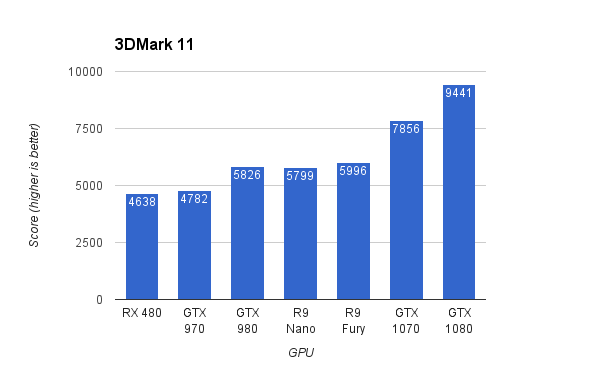
Right out of the gate, things don’t look so rosy for the RX 480 in our synthetic test. The GTX 1080 towers over it by 51 percent, which is one of the biggest performance differences between the two cards that you’ll find in my tests. The GTX 980, R9 Nano, and R9 Fury are all faster than the Polaris card by roughly 20 percent. Even Nvidia’s more modest GTX 970 is able to edge it out by three percent here. To be fair, this is one of the few instances in which the GTX 970 beats the RX 480.
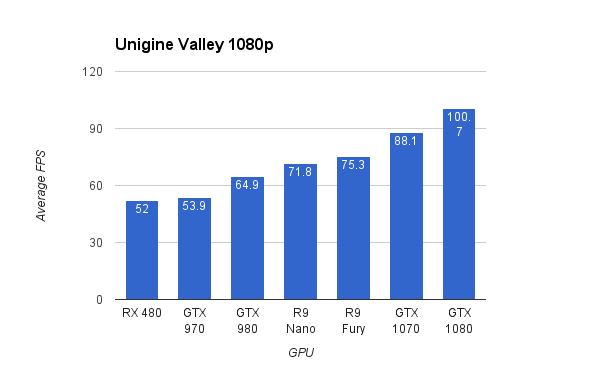
In the graphically demanding synthetic Unigine Valley benchmark, the GTX 970 edges out the RX 480 once again; this time, with a four percent advantage. This, once again, makes AMD’s budget-oriented card the slowest of the bunch.

BioShock Infinite at 1080p is the first benchmark (of many) which shows the RX 480 being faster than the GTX 970. It's only a two percent lead here, which isn't huge, but both cards are able to render over a 100 average FPS in Irrational Games’ shooter. While the GTX 1080 holds a significant 34 percent lead over the RX 480 here, this test actually represents the smallest performance delta between the two cards out of all my benchmarks.

While the RX 480 was only marginally faster than the GTX 970 in BioShock, it’s significantly much faster with a 13 percent advantage here. It is slower than everything else by about 10-44 percent, however. Still, with the card maintaining a 44 FPS average in Metro Last Light, it proves that the RX 480 is able to hang with the most demanding games at 1080p, since the Last Light benchmark is simply brutal.
The RX 480 is able to hang with the most demanding games at 1080p
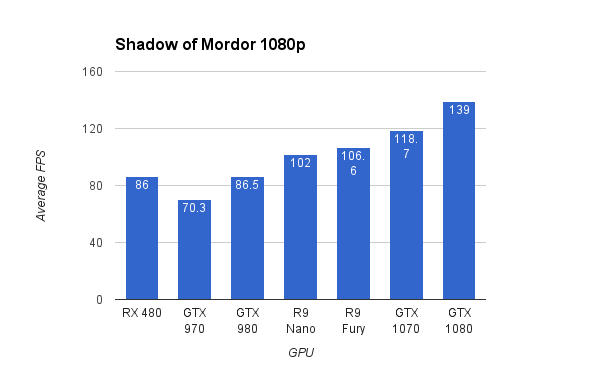
If the 14 percent lead the RX 480 held over the GTX 970 wasn’t enough in Last Light, it proves it dominance here in Shadow of Mordor at 1080p with a huge 22 percent advantage. It’s also in a statistical tie with the GTX 980, which is impressive considering that card is currently $200 more expensive.

While the RX 480 maintains a four percent lead over the GTX 970 with an average FPS above 90, it lags 45 percent behind the GTX 1080, which is the largest game benchmark delta between the two cards. To be fair, the GTX 1080 is completely overkill here with a nearly 170 FPS average.
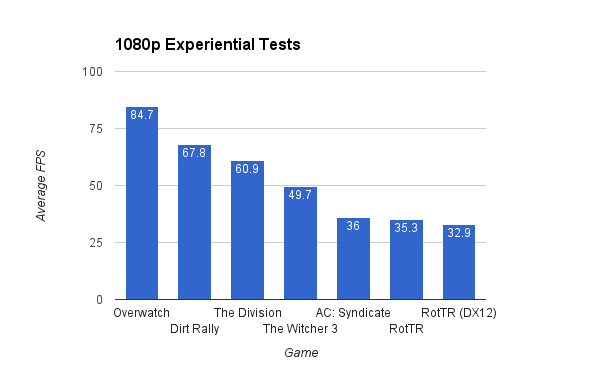
In our experiential tests, the RX 480 was able to get playable frame rates in every title and got over 60 average FPS in The Division, Dirt Rally, and Overwatch. It did dip into the 30s with the graphically taxing Rise of the Tomb Raider and Assassin’s Creed: Syndicate games, however.
1080p Conclusion: While AMD is positioning the RX 480 as a 1440p graphics card, I think it’s a great card for maxing out 1080p titles. Yes, it is overkill for many games, where it will easily get above 60 average FPS, which is above the refresh rate of most monitors, but if you’ve got a high-refresh rate monitor, this is a great card for you. Also, super grueling games like Metro Last Light and Rise of the Tomb Raider are still really able to push the card here with average frame rates dipping into the 30s and 40s.
1440p Benchmarks

The RX 480 and the GTX 970 end up in a statistical tie at 1440p with the Polaris card edging out Nvidia’s Maxwell GPU by a hair. Considering the GTX 970 beat the RX 480 by four percent at 1080p, however, this is a marked improvement. Regardless, both cards are barely able to cross the 30 FPS average hump here.
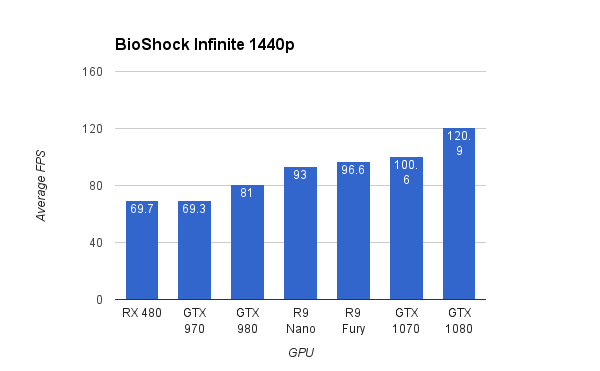
Once again, the RX 480 and GTX 970 end up in a dead heat in BioShock Infinite. Both cards are able to get over the vaunted 60 average FPS threshold at 1440p, however.
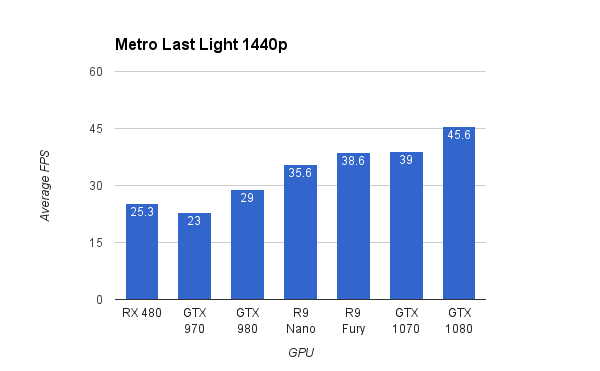
While the RX 480 beats the GTX 970 by 10 percent, this advantage isn’t enough to make Last Light playable at 1440p. With an average FPS of 25.3, this test proves that the RX 480 won’t be able to smoothly max out the most graphically-intensive games at 1440p.
The RX 480 won’t be able to smoothly max out the most graphically-intensive games at 1440p.
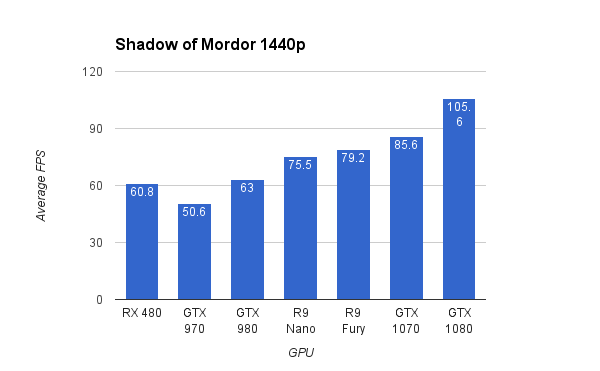
The RX 480 enjoys a big 20 percent lead over the GTX 970 here. It means the difference of gaming at 60 average FPS vs 50. You may notice that it also comes within spitting distance of the much more expensive GTX 980, which is rare.

The RX 480 maintains an eight percent percent lead over the GTX 970 running Tomb Raider at 1440p, which is just fast enough for it to get an average FPS above 60.
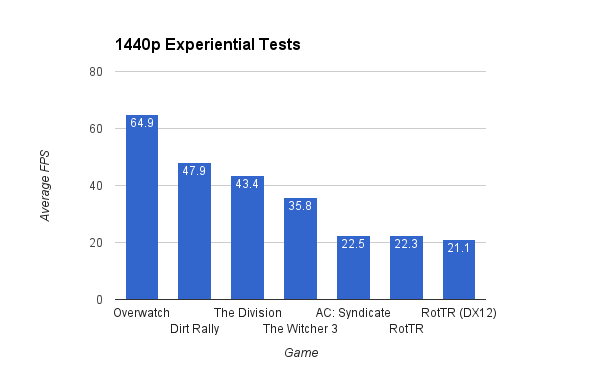
While the RX 480 was able to hold its head above 30 average FPS for the majority of our games at 1440p, and even made the Witcher 3 playable at Quad HD, Assassin’s Creed and Rise of the Tomb Raider proved to be too graphically taxing for the GPU to handle here.
1440p Conclusion
AMD is pushing the RX 480 as a 1440p card. I have no doubt that it will be able to effectively max out the majority of games with an average FPS of 30 and above, but it does falter with graphically demanding games like Metro Last Light or poorly optimized titles (Assassin’s Creed: Syndicate, I’m looking at you). In these situations, average frame rates dip into the 20s. It’s not like you won’t be able to play the most demanding games at 1440p, it’s just that you’ll have to make compromises and turn down some graphical bells and whistles, or suffer the wrath of choppy frame rates.
4K Benchmarks
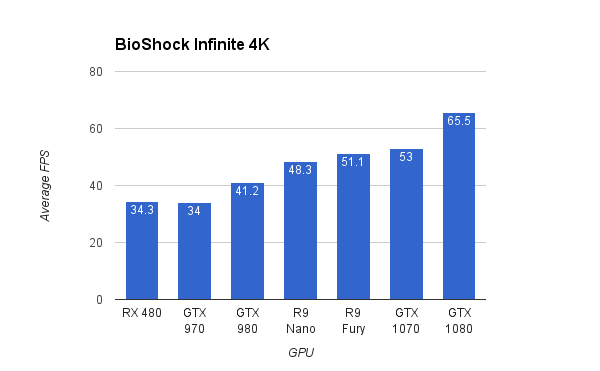
The RX 480 statistically ties with the GTX 970 here at 4K with both cards getting around 34 average FPS, which is just barely above the average 30 FPS threshold.

The RX 480 took a huge performance nose dive in 4K. With a poor 9.3 average FPS, it’s slower than the GTX 970 by seven percent. Even though the mighty GTX 1080 can’t effectively play the grueling game at 4K either, it essentially runs twice as fast as the RX 480.

Things revert back to normalcy with our Shadow of Mordor 4K benchmark. Here, the RX 480 has a 19 percent lead over the GTX 970. This delta is large enough to bring it above the playable 30 average FPS threshold.

While the RX 480 took a bit of a nose dive running Last Light at 2160p, in Tomb Raider running at 4K, we see the GTX 970 take a huge fall. This could be due to the card’s smaller 4GB GDDR5 framebuffer. The RX 480, on the other hand, is barely able to muster a 30 FPS average, though you’ll probably want to turn down graphical settings to avoid any inconsistent frame rate dips here.
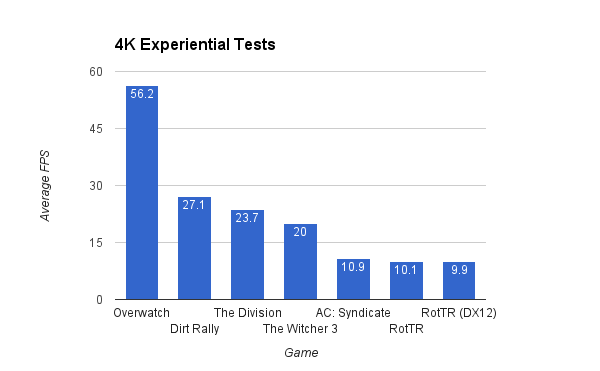
Things did not look good for the RX 480 in our 4K experiential tests. The only game it was able muster playable framerates was in Overwatch, which isn’t a very graphically demanding game. And even here, it was shy of reaching the esteemed 60 average FPS threshold. Everything else was just completely unplayable and AMD’s drivers even crashed on us once playing The Witcher 3.
4K Conclusion:
The RX 480 was not a card designed for 4K, and it shows. While it can run some moderately demanding games above 30 average FPS, it often does so by the skin of its teeth. At that point, you’re better of playing at a lower resolution or turning down graphical settings to get a smoother experience.
The RX 480 was not a card designed for 4K, and it shows.
VR Benchmark
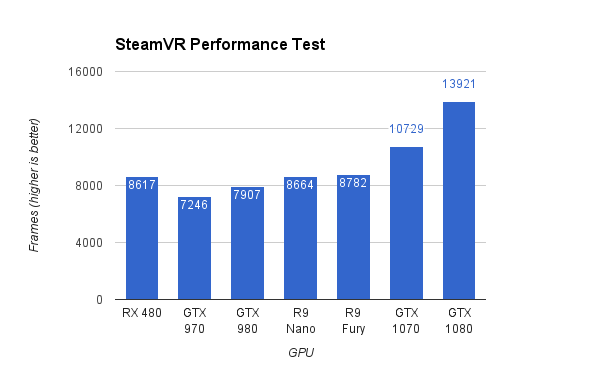
AMD is pushing the RX 480 as a VR-capable card that rivals $500 GPUs. While I’d like to test this particular claim in-depth, there’s only one VR benchmark at the moment, which is Valve’s SteamVR Performance Test. Luckily, the RX 480 really shines here and does make a case for AMD’s assertion. The Polaris card is not only faster than the GTX 970 here, but it’s also faster than the 980 and even rivals AMD’s own $500+ Fury and Nano graphics cards. Whereas the test rates Nvidia’s GTX 970 as “VR Capable,” the RX 480 earns a higher “VR Ready” score. If you want an affordable card for VR, the RX 480 is what you seek.
If you want an affordable card for VR, the RX 480 is what you seek.
RX 480 Temperatures, Noise, and Overclocking
AMD is saying that you’ll get a cool and quiet gaming experience with the RX 480. In my experience, it nails the quiet part, but doesn’t really keep its cool. While the card can top out at 5,200rpm, which can sound like a small, but aggressive wind tunnel, running the Unigine Valley benchmark, I witnessed it revving at a much quieter 2,200rpm. With a core clock that ran around 1240MHz, it reached around 85 degrees Celcius here. This is pretty hot for a card running at stock clocks.
Does the heat hinder the card’s ability to overclock? Well, your mileage may vary with every GPU overclocking differently, but I saw about an eight percent performance boost out of my particular card.
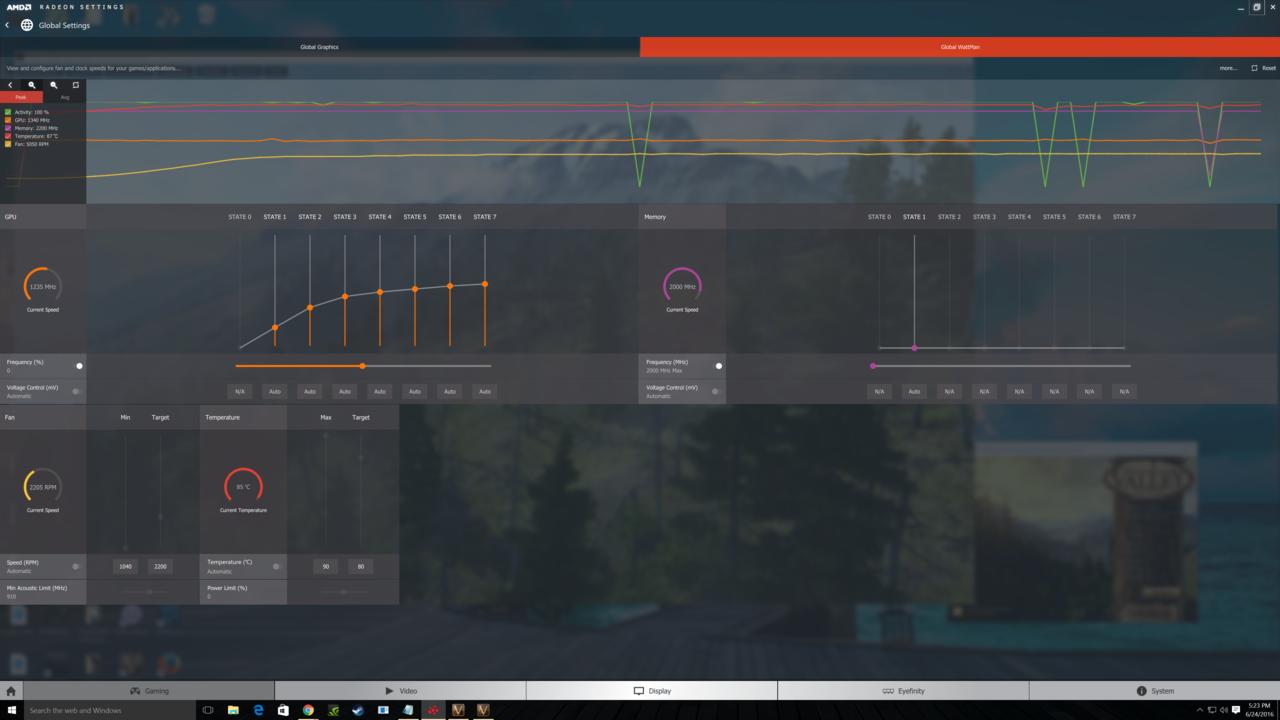
With the RX 480, AMD is rolling out a new overclocking tool called Radeon WattMan, which replaces AMD OverDrive. The new app provides a deeper level of customization that allows you to tweak overclocks, voltages, and temperatures over up to eight different states. AMD says that the card is able to switch between these states on the fly in just a few nanoseconds.
I simply tried to push the card to its overclocking limit, however, by cranking the fan speed to 100 percent (5,200rpm) and was able to push the core clock up six percent with the memory frequency offset going up by 150MHz. Underload, this brought the clock speed up to 1340MHz and the temps to 78 degrees C. Overall, it’s not a horrible overclock, but it’s not especially great either.
Conclusion
If you’re hoping that AMD’s Radeon RX 480 would be able to match Nvidia’s GeForce GTX 1070 GPU in any way for $240, then you’ll be sorely disappointed. It is perhaps not the new flagship GPU that many AMD hopefuls were waiting for. For a performance pusher, it sounds like you’ll have to wait for AMD to release its Vega GPUs sometime later on down the road. The fact of the matter is that it’s slower than AMD’s own Fury X, Fury, and Nano graphics cards. It’s also largely slower than 2014’s GTX 980.
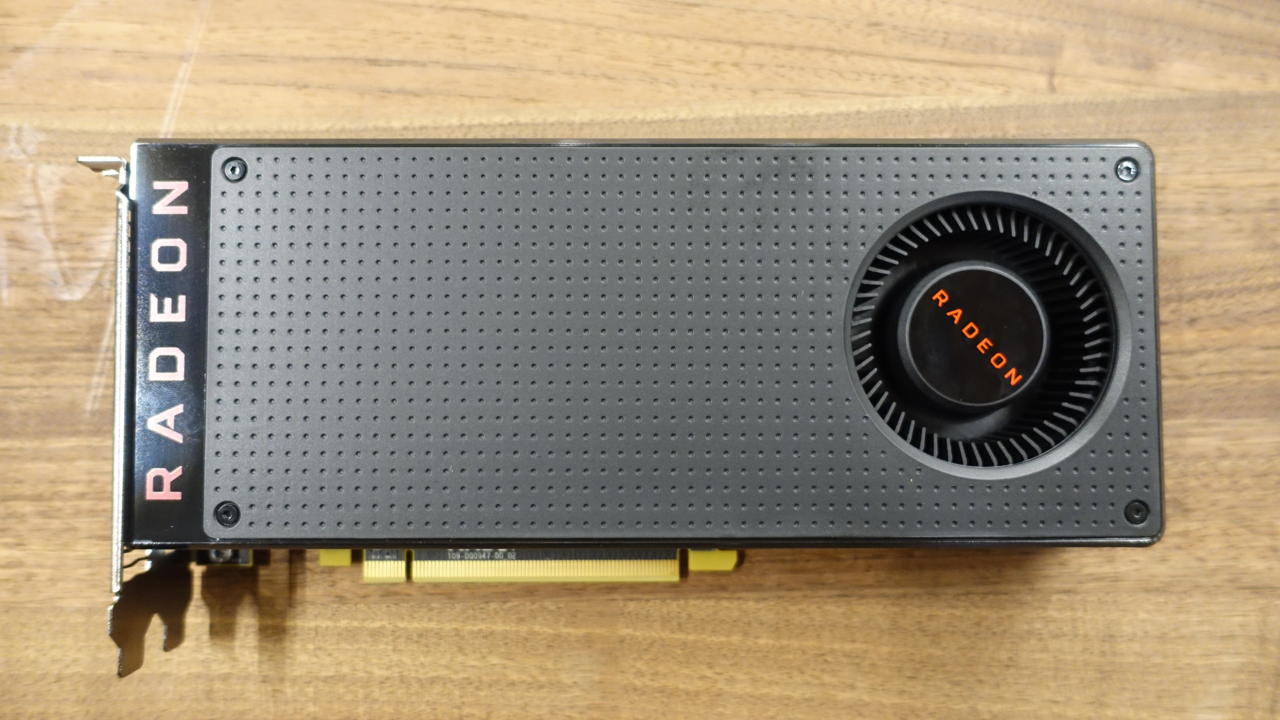
I don’t want to give the impression that the card is mediocre, however. It’s far from it. It’s essentially a budget-priced card that’s able to perform as well as a mid-to-high range card, and that’s nothing to scoff at. It beat Nvidia’s GTX 970 in 13 of my 16 tests by an average margin of 13 percent, while costing roughly a third less. That’s impressive. Yes, it is about a third slower than the GTX 1070, which is an incredible deal from Nvidia in its own right, but it currently cost roughly half as much.
It’s essentially a budget-priced card that’s able to perform as well as a mid-to-high range card
The RX 480 is an awesome card for 1080p that will be able to max out just about every game you throw at it. It will also let you go waist deep into the 1440p pool as well. Perhaps more important, however, is that it does a good job of bringing VR affordability to the masses. Its performance may not blow you away, but neither will its price tag.
Got a news tip or want to contact us directly? Email news@gamespot.com
Join the conversation